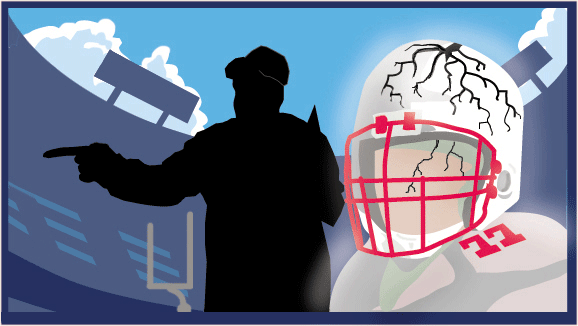
Concussion hazards must be addressed
Concussions are coming out of the closet as the downside of football -- one that jeopardizes both players and the long-term viability of the sport. The NFL claims progress is being made. On opening day, linebacker Stewart Bradley of the Philadelphia Eagles was hit hard in the head; his legs turned to jelly and he collapsed. A few minutes later, he was sent back into the game. That's progress? Football has a long way to go until it can claim to be taking concussions seriously.
Many actors in what ESPN's Brian Kenny calls the "sports-industrial complex," including ESPN, share some blame for the situation. But let's start with the core problem.
The core problem is that football coaches at the high school, college and professional levels are rewarded for winning games but not penalized for allowing their players to be harmed. A coach who sits a player down out of concern for the player's health may pay a price, if a game is lost. A coach who sends a concussed player onto the field may never be penalized in any way if that player suffers another concussion. Human beings respond to incentives, and right now the coaches' incentive is to be irresponsible with players' health.
TMQ CHEAT SHEET

Gregg Easterbrook on …
Yes, the culture of football macho contributes to the problem: Many players ask to return to action when battling injury, including neurological harm. But coaches are the ones who make the decisions. They're the adults in charge. And their incentive structure is all wrong.
Coaches receive money and accolades if they mistreat players and win; they are not disciplined, or seemingly even criticized, if players are harmed. Same for the front office in the NFL, the athletic department in college and the athletic director in high school. If the team loses, the fans and boosters are furious. If players suffer harm, there are no consequences whatsoever for the people making the decisions. And at the high school level, legally they are caring for children!
What penalty did Andy Reid suffer for sending Bradley back into the game? None. Nor did the Eagles organization pay any price for skirting commissioner Roger Goodell's 2009 order that players with concussion symptoms sit down until evaluated by an independent neurologist. Eagles spokesperson Derek Boyko told me that because Bradley merely came out of the game, rather than being "removed," the policy did not apply.
That the league describes itself as "comfortable" with Bradley re-entering the game without being examined by a neurologist suggests that Goodell's concussion policy is toothless. Boyko said Philadelphia had no neurologist on the sideline: that team physician Gary Dorshimer, an internist, cleared Bradley to re-enter. This Sunday, the Dallas Cowboys' team physician refused to allow tight end Jason Witten to re-enter the game after he took a blow to the head. This showed that awareness of head trauma is spreading. But team doctors face only their own conscience, not any binding NFL standard, when deciding whether players may re-enter a game.
Of course, concussion risk cannot be eliminated; players know they are assuming some risk. There are many pluses that balance the risk -- in most cases, it's a wonderful experience to be a football player. And head trauma happens in other sports. Concussions are surprisingly common in soccer, which many soccer moms falsely view as a tame event in which boys and girls just jog around in colorful outfits.
For any sport, the goal must be cautious management of concussions. Just like an injured ankle, an injured brain needs time to heal. If cared for properly, most who suffer concussions will recover nicely. If a concussed player is returned to games or practice too soon, concussion harm can become much more severe -- and for long-term health, neurological damage is a greater concern than orthopedic damage.
Some football coaches are persons of character who always put their players' health first. Most do not. As long as coaches know there is no penalty for mistreating concussed players (or ignoring other health issues), coaches will continue to use players up and throw them away. Not only will many players' brain health be harmed, but at some point Congress or state legislatures may say "Enough!" and impose legal standards that the football world will like a lot less than enlightened self-regulation.
Here are other important concussion matters:
• Increasingly, researchers think concussions are not as much the result of one spectacular hit as the accumulated effects of many lesser impacts -- in the same way a prizefighter may appear unharmed by the first several hard punches, then be knocked out by a routine jab. This suggests that the way football teams practice is as important to reducing concussion risk as the way they play. A forthcoming study in the Journal of Athletic Training will show that the players of a typical Division I football team during the course of a season endure about 3,000 hits to the head in practice, 500 of them strong hits.
Many coaches at all levels of football encourage players to go after each other brutally in practice. The worst happens in high school, where coaches may encourage older, stronger varsity players to beat up on younger junior-varsity players. (Idiots view this as a display of manhood.) If the accumulated effects of lots of small hits to the head are a leading cause of concussions, then football needs best-practices standards for practice. There are no such standards now in high school, college or the pros. Neutral observers at practice would help, too. Generally, only players know what transpires in practice, and at all levels of football, the majority of players are terrified of telling outsiders anything that reflects poorly on their coaches.
• Trainers are not necessarily certified for concussion treatment; many high schools don't have a certified trainer present at practice. (Many coaches don't even know basic first aid. I've observed with my own eyes high school football coaches who have no clue what the symptoms of heat stroke are.) Coaches are not required to pass a concussion-awareness course. Courses on head trauma should be mandated for coaches and trainers.
Here is a free online course on concussion awareness and care. It's from the National Federation of High Schools, which was two years ahead of the NFL in making prevention of helmet-to-helmet hits a point of officiating emphasis. The course requires cumbersome registration, but is very useful.

• Reader Thomas Michalsen of Livonia, Mich., writes, "As a high school football coach, I have noticed that many NFL players are not wearing mouthguards or wearing what is really a 'mouthpiece,' the thin kind designed for non-contact sports. What NFL players do filters down to high school, where kids don't want to wear mouthguards because they observe the pros not wearing them. Proper mouth guards are essential to reducing concussion instance and severity. Recently the NFHS, whose sports rules are followed in most states, mandated that mouth guards be large enough to be readily visible to officials. Why can't the NFL adopt a visible mouth-guard rule, and set a good example?" Michalsen continues, "The NFL should also require all players wear the kind of mouth guard that is strapped to the helmet, so it is obvious to officials -- and to young people watching -- that the player has a full-sized mouth guard."
The overwhelming majority of football players are at the high school level, so it is here that the mouth-guard issue matters most. Ideally, every player should have a Type III mouth guard made by a dentist. (Type I is flat, Type II is boil-and-bite, Type III is custom-fit.) At the least, states and counties should require that a dentist visit high school teams at the beginning of summer two-a-days to check the fit of mouth guards. What might this cost, a couple hundred dollars for the dentist's time? And if even one concussion is avoided?
• The new high school rule on removing concussed players from games and practice is stronger than the NFL rule. Why is the NFL letting high school be the cutting edge of progress, instead of the NFL taking a leadership position on this issue?
• Goodell urged all states to pass a law prohibiting young people with concussion symptoms from returning to games unless cleared by a doctor. Only Connecticut, New Mexico, Oklahoma, Oregon, Virginia and Washington currently have such laws. All other states should enact such statutes. Why doesn't the NFL set a better example through its own behavior?
• Those helmets you see flying off NFL and NCAA players? A flying helmet means the helmet doesn't fit properly or the chin straps weren't secured -- or both. Loose helmets or unfastened straps increase concussion risk and can expose a player to neck injury. Reader Jim Yrkoski of Warsaw, Poland, asks: "Wouldn't concussions be reduced if today's players wore helmets that fit properly? The helmets I wore back in the '80s while playing high school football required the player to pull outward from the ear holes in order to get the helmet off. Today's players take off helmets as if they were baseball caps."
Helmets themselves are getting better -- new Riddell and Schutt models reduce concussion likelihood, and the Xenith helmet eventually may be shown to be even better. Bad enough that the NFL refuses to mandate helmets that reduce concussion likelihood, but the NFL won't even mandate that helmets fit properly! If a player wants a loose helmet that pops off like a baseball cap, that is seen as the player's choice. (Many players don't know loose helmets increase risk; many trainers don't seem to know this, either.) Starting a play with your chin strap not secured is a penalty, but officials rarely enforce this rule. Crack down on the rule leaguewide for one NFL Sunday and behavior would change fast.
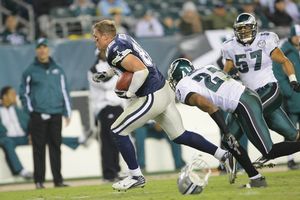
High school boys see helmets flying off on television, think it's cool, want a loose-fitting helmet and don't keep their chin straps fastened. Ensuring proper helmet fit and enforcing the straps-buckled rule are low-cost, immediate steps to reduce concussions.
• Sportscasters should take some blame for averting their eyes from concussions and for excessive praise of big hits. Many sportscasts, including on ESPN, single out big hits as highlights. On Sunday night, Antoine Bethea drilled a defenseless Giants player. "What a shot!" Al Michaels of NBC said. "Oh boy, I tell you he laid the wood!" Cris Collinsworth said. Often, big hits are praised more than other athletic feats, such as blocking, tackling, throwing and catching. Much of football actually isn't violent -- but the violent parts are extolled on-air. This causes football players at all levels to want to make big hits the announcers will gush about -- and big hits raise the danger level of the sport.
When NFL and college players cause concussions with illegal helmet-to-helmet or helmet-as-a-weapon hits, sportscasters ought to denounce this. Instead they often praise such hits or make jokes about "getting your bell rung." The message sent to young players is: Hit with your helmet, kid. It's manly. There are no consequences, and the sports media will exalt you.
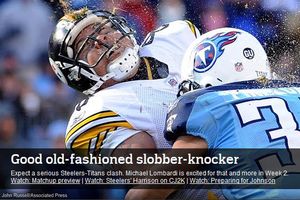
Last season, NFL Network, which is owned by the league, made fun of Clinton Portis of the Washington Redskins for suffering the concussion that ended his season. "Night-night," Deion Sanders said, laughing, as a clip rolled of Portis collapsing. "He's going to sleep. He's dreaming." NFL Network apparently thought a concussion was entertaining -- a highlight! (Look here about 20 seconds in.) On Saturday, the front page of NFL.com showed the head of Hines Ward of the Steelers being driven backward by what looked like an illegal helmet-first hit. Was it an article about concussion safety? "GOOD OLD-FASHIONED SLOBBER-KNOCKER" was the headline of a story about how the Pittsburgh-Tennessee game should feature plenty of violent hits.
Fox announcers Troy Aikman and Joe Buck expressed concern when Bradley collapsed in the Packers-at-Eagles game -- then raised no questions when he came back onto the field. Richard Sandomir of The New York Times has details here.
In this and similar instances on all networks that broadcast football, there is scant discussion of safe tackling form. "See what you hit" is what progressive football coaches teach. Safe tackling form reduces concussion risk -- if a player can see what he's hitting, he is not leading with the head. Networks should criticize players who use illegal tactics and single out those who demonstrate safe tackling form. That would set a positive example. Instead, announcers praise dangerous hits.
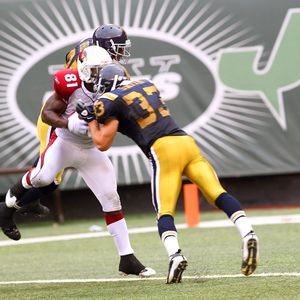
During last week's "Monday Night Football" opener, the Baltimore Ravens at New York Jets, in the fourth quarter, a play paired Eric Smith and Anquan Boldin. In 2008, they were involved in one of the worst head-to-head hits ever. Both collapsed with Grade III concussions; Boldin's jaw required reconstruction; Smith was suspended for "flagrant violation of player safety rules." Here is what the announcers said:
Jon Gruden: The last time Boldin played here, he had, I don't know, what, 40 titanium screws put in his cheekbone, Mike. He took one of the great hits of all time, and here he is. He looks like it never happened.
Ron Jaworski: He took that hit, and he played a couple weeks later. It was one of the most incredible recoveries you'll ever want to see. You think of a tough guy, that's an NFL tough guy, Anquan Boldin.
Mike Tirico: It was a very scary scene, you remember, in Week 4, 2008. Boldin was hit. Eric Smith, who's starting at safety for the Jets tonight, ends up with that hit to the face that ended up doing the damage. Seven plates, 40 titanium screws, he only missed two games. Kurt Warner was so disturbed by the injury, he even thought of retiring at that point; it really affected Kurt so much. But as we said, only a couple games later, and Smith, who got the hit, was fined and suspended a game, but he and Boldin spoke right after and Boldin told him, "Keep playing that way. That was a freak accident."
A double Grade III concussion caused by a flagrant violation was "one of the great hits of all time." Taking the hit made Boldin a "tough guy." Incredible recovery. Long-term neurological damage goes unmentioned. Safe tackling form is not mentioned. A high school athlete listening to this dialogue would think getting a concussion is a football badge of honor.
Football announcers are uncomfortable with questioning any underlying presumption of the sport. Their impulse is to praise, while pretending no one ever suffers lasting harm -- that, after all, is what the audience wants to believe. Like coaches, sportscasters will not change until their incentive structure changes. This means sports media must look into the mirror, just as the NFL must. Contact using the head should never be extolled, and announcers should be honest about the downside of football. Maybe if the harm from concussions were discussed openly by sportscasters, awareness would rise and maybe playing rules and medical standards would be reformed to reduce the odds of neurological damage. That would help sustain the great sport of football for the long term.
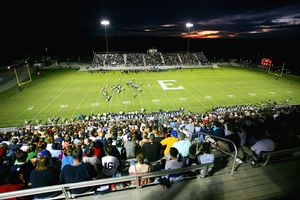
• In last year's season finale of "Friday Night Lights," one of the good guys delivered a helmet-to-helmet hit that knocked the other team's star out of the game with blurred vision. The players and spectators are shown cheering, while lead character Eric Taylor, the coach, claps enthusiastically. No penalty is assessed, and no mention of safety or proper-form tackling is made.
Unlike game announcing, which is spontaneous, this scene was scripted and rehearsed. It was negligent for the "Friday Night Lights" producers, and NBC, to glamorize concussions. If you were a kid watching that episode, what was your takeaway? Hit with your head. It's manly. There are no consequences.
Stat of the Week No. 1: The Denver Broncos have won 11 consecutive home openers.
Stat of the Week No. 2: Since Brett Favre arrived, the Minnesota Vikings have followed a 10-1 streak with a 3-5 streak.
Stat of the Week No. 3: Stretching back to last season, the Baltimore Ravens have not allowed a touchdown for nine quarters -- and are 1-2 in that span.
Stat of the Week No. 4: Chris Johnson of the Tennessee Titans was held to less than 100 yards rushing for the first time in 13 games -- by the Pittsburgh Steelers' defense, which has allowed a hundred-plus rusher only once in the past 36 games.
Stat of the Week No. 5: The Dallas Cowboys have lost both opening games at their new $1.3 billion stadium.
Stat of the Week No. 6: The Jacksonville Jaguars have lost their past three games played in California by a combined 99-16.
Stat of the Week No. 7: Jacksonville and the Tennessee Titans combined to commit 13 turnovers.
Stat of the Week No. 8: The Cincinnati Bengals have won eight straight AFC North contests.
Stat of the Week No. 9: In Week 1, the Steelers scored a touchdown on the last play of the game. In Week 2, the Steelers scored a touchdown on the first play of the game. Thus Pittsburgh scored touchdowns on consecutive plays. Noted by reader Yuki Urabe of Kobe, Japan. Four NFL teams started quarterbacks drafted by the Atlanta Falcons (Brett Favre, Matt Ryan, Matt Schaub and Mike Vick), and they went 3-1. Noted by reader Brian Sanders of Atlanta.
Stat of the Week No. 10: In Arena League action, the Washington Redskins and Houston Texans combined for 871 yards passing and 76 yards rushing.
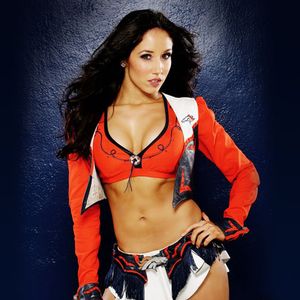
Cheerleader of the Week: Serita of the Broncos, who is also the September pin-up on the Broncos Cheerleaders' calendar. According to her team bio, she works as an accountant. A cheer-babe accountant? "The accountant will compute your taxes as soon as she finishes posing for the bikini calendar."
Sweet Play of the Week: Brett Favre re-re-re-returned to the Vikings in part because Minnesota has Adrian Peterson and a well-regarded offensive line. So when the Vikings, trailing 14-10 with 2:21 remaining, lined up on fourth-and-goal on the South Florida Dolphins 1 -- Peterson in the backfield, six offensive linemen in the game -- success seemed likely. Instead, the Dolphins stuffed an off-tackle run, a sweet defensive play.
Vontae Davis, emerging as one of the league's best corners, helped break up the Minnesota blocking wedge. When a cornerback breaks up your wedge at the goal line, your team has issues. Favre looked 40 years old, at one point heave-hoing a pass into double coverage. Miami won despite drive starts on its own 1, 1 and 2. Starting on their 1, the Dolphins got a 51-yard first-down rush from Ronnie Brown behind perfect blocks by Jake Long and Rich Incognito. As usual, Minnesota's Jared Allen was trying for a sack and did not contain a play headed his way.
Sour Play of the Week: Leading 7-3, the San Diego Chargers faced third-and-goal on the Jax 9. Antonio Gates, favorite target of the Bolts in the red zone, split left and ran a quick in-out-in move. By the second in, he was covered by no one. The Jaguars had lined up in "quarters," with defensive backs each taking a quarter of the field -- and every Jacksonville defender ignored the other team's best red zone threat, who entered the contest with 60 touchdown catches.
Sour Play of the Week No. 2: With City of Tampa leading 20-7 with 3:35 remaining, the Carolina Panthers faced fourth-and-goal on the Bucs 1. The Panthers came out in a 1950s-style power set with three tight ends and two backs, then ran a sloooooo-developing run that was stuffed. At the goal line, plays must go straight ahead or involve deception -- no deception coupled to sloooooo-developing is a sour formula.

Sweet 'N' Sour Play:
San Francisco played most of "Monday Night Football" in Cover 4, a defense usually reserved for the final two minutes of the half -- both safeties deep, both corners playing off then backpedaling at the snap. The Squared Sevens seemed determined to prevent the New Orleans offense from lighting up, and the tactic succeeded. Sean Payton called lots of rushes and underneath passes, the Saints averaged just 4.5 yards per offense snap, well below their league-leading 6.3-yard average of 2009 and below this year's average for the Oakland Raiders offense. Minnesota and San Francisco both have tried backed-off coverage against the Saints, and it has slowed their scoring. Now everybody has film of this coverage upsetting the Boy Scouts' deep attack -- surely they will see more Cover 4 in weeks to come.
Frustrated as they were, the defending champions still made the necessary plays. After San Francisco took its sole lead at 14-9 in the third quarter, New Orleans staged a drive that consisted of two Niners penalties plus gains of 9, 3, 11, 5, 2, 8, 4 and 3 yards. Ho-hum but the result was a touchdown. Reaching third-and-goal at the 3, New Orleans lined up with double receivers on each side and blocking tight end David Thomas in the backfield, then sent Reggie Bush in motion from a slot receiver position nearly to the left sideline. At the snap, New Orleans had two wide receivers on the right plus Thomas on that side in the backfield; San Francisco had four defensive backs on that side. The two wide receivers both cut toward the center of the field, and two defensive backs followed them. Thomas ran a short curl and was uncovered, touchdown, and the defending champions never looked back. That was sweet. San Francisco had four defensive backs facing three receivers, and no one covered one of the receivers. That was sour. The Cover 4 mindset had Niners defensive backs so backpedal-oriented that Nate Clements, closest to Thomas, was backpedaling away from him as the play started, though all he needed to do was step across the goal line and turn around.
Stretching back to last season, New Orleans has played five consecutive nationally televised we're-the-only-ones-on-right-now games and won them all.
On the final snap of the third quarter, trailing 16-14, Mike Singletary sent in the punt unit on fourth-and-1 from his 27. San Francisco hasn't reached the postseason in nine years. The game is at home, on "Monday Night Football," against the Super Bowl champions. On the night, the Niners rushed for 142 yards and a 5.5 yard-per-carry average. You can't dance with the champ, you have to knock him down. That fourth-and-1 was a chance to reverse years of losing psychology in San Francisco -- and boom went the punt.
Sweet Specia-Teams Play: Trailing Pittsburgh 19-11 with 58 seconds remaining, the Titans lined up to onside kick. Tennessee bunched most players left, showing a left onside; when the kicker started moving, players sprinted right and the kicker turned to the right; then he kicked straight ahead, recovered by Tennessee. The Flaming Thumbtacks didn't win, but the onside was sweet.
Stop Me Before I Blitz Again! Greg Olson of the Chicago Bears caught a 39-yard touchdown pass against a Dallas seven-man blitz; Steve Smith of the Panthers caught a 37-yard touchdown pass against a Bucs six blitz. But the Armageddon of the blitz came in the Houston at Washington collision.
On opening day, Redskins defensive coordinator Jim Haslett called a dozen safety blitzes against Dallas, a high number, and the Skins escaped with a one-point victory on the final snap. On Sunday, Washington held a comfortable 17-point lead over the visiting Texans late in the third quarter. Play straight defense, and victory is likely. Instead, Haslett called 19 blitzes on the 40 remaining Houston snaps; Washington lost in overtime. Houston ran 40 plays from the late third quarter on? That's the sort of thing that happens against a blitz-wacky defense. Blitz, blitz, blitz resulted in 526 yards of offense, 29 first downs and 30 points allowed.
If you were wondering why NFL teams don't blitz constantly -- listening to sportsyak, you'd think the blitz is a magic formula for instant success -- the Washington collapse against Houston is your answer.
The low point came with the Redskins leading 27-20, the Moo Cows facing fourth-and-10 on the Washington 34 just before regulation's two-minute warning. Washington did not need a sack or turnover, just an incompletion. The Skins blitzed, leaving Andre Johnson -- among the league's best players -- single-covered in the end zone by safety Reed Doughty. Johnson outleaped Doughty for the touchdown that caused overtime, a great catch. Three Skins defensive backs from the nickel package were standing in the center of the field covering no one, as the opposition's best player was single-covered in the end zone. This is the sort of thing that happens when a team blitzes too much.
Disclaimer of the Week: Reader Marc Bush of New York City reports, "The iTunes Store Terms & Conditions that I was required to agree to before I downloaded upgraded apps on my iPhone was 62 pages long. Who knows what is buried on Page 57 of this contract?" Reading 62-page disclaimers -- shouldn't there be an app for that? My guess, Marc, is that on Page 57 you assigned to Apple all intellectual property that will ever be created by your descendents.
Adventures in Officiating: Early in the Philadelphia-Detroit game, DeSean Jackson made a falling-down catch/no-catch nearly identical to the Calvin Johnson catch/no-catch in the end zone at the end of the opening day Detroit-Chicago game. When officials initially ruled completion, Lions coach Jim Schwartz entered into a condition that cannot be described on a family website. Fox, which televised the game, promptly switched to former NFL head official Mike Pereira, who now works as a commentator. "This is a tough one … it will be a tough call," Pereira said, refusing to commit himself on whether the pass was complete. If the former head of NFL officials can't understand the falling-down catch/no-catch rule, how can anyone else?
On the Calvin Johnson play, the consensus among touts and league officials was that the pass should, indeed, have been ruled incomplete. TMQ saw a touchdown. Here's the rule, with boldface added: "If a player goes to the ground in the act of catching a pass (with or without contact with an opponent), he must maintain control of the ball after he touches the ground, whether in the field of play or the end zone. If he loses control of the ball, and the ball touches the ground before he regains control, the pass is incomplete. If he regains control prior to the ball touching the ground, the pass is complete."
If a receiver snatches a pass in the air and the ball bounces away when he touches the ground, everyone agrees that's an incompletion. But Johnson maintained control "after he touched the ground." He came down with both feet, in full control. Then he took a stride, fell, and the ball bounced away. When he came down with both feet, the play should have ended because that breaks the end zone's plane. By common sense, TMQ saw a touchdown. By the wording of the rule, TMQ saw a touchdown!
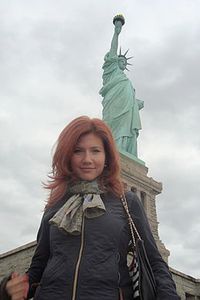
What about "the process of the catch" and "performing a second act?" Good luck finding either in the rulebook. Reader Matt Toaz of Ann Arbor, Mich., writes, "I maintain that we don't know who is right about the Johnson catch/no-catch because the NFL will not publish its rule book." The rulebook is public -- but the officiating manual, which tells zebras how to run the game, is not. The National Federation of High Schools will sell you its football officiating manuals, and the NCAA posts some of its rules online. The NFL maintains that its officiating manual is a trade secret -- I've asked for a copy in the past and been rebuffed. A trade secret -- the Russians don't know how we call completions? What if the Iranians found out how we signal ready-to-play!
Maybe in the NFL officiating manual, or at the clinics NFL officials annually attend, "process of the catch" and "second act" are spelled out in a way that means the zebras at the Detroit-Chicago game were doing their job. But secret rules? Beyond silly.
Dr. Jekyll and Mr. Martz: Bears offensive coordinator Mike Martz can drive you crazy with odd calls -- that's his Mr. Martz side. But when he's Dr. Jekyll, he can be terrific. With Chicago leading 17-14 with 54 seconds remaining in the first half, the Bears faced fourth-and-1 on the Cowboys 24. Chicago lined up to go for it. Jay Cutler barked some signals and looked around casually, almost tapping his feet. Everybody thought the Bears were trying to draw the Boys offside, and if they didn't, would call time and kick. Suddenly, Cutler snapped the ball and sneaked for a first down. The play was a fake of trying to draw the defense offside! Outstanding.
As for Dallas, TMQ noted last week that for a team representing the state that is the center of football culture, the Cowboys have awfully low football IQ. On the key down of the season-opening loss to Washington, Tashard Choice, hemmed in by tacklers with no chance of advancing the ball, tried to struggle forward for an extra stats-padding yard and fumbled. The Cowboys won't ever make that mistake again, will they? Trailing 27-17 with 4:40 remaining, Dallas has first-and-10 on the Chicago 37, holding two timeouts -- the game is far from over. Roy Williams, hemmed in by tacklers with no chance of advancing the ball, tried to struggle forward for an extra stats-padding yard and fumbled. Chicago ball, now the game is over.
Didn't the ever-grimacing, always-wincing Wade Philips have his team watch film of the Choice fumble? Didn't the players learn anything? Stretching back to last season, Dallas has lost three straight and scored two offensive touchdowns in that span. The Boys could use some work on wrap-up tackling, too.


Affordability Was, As Usual, Skipped: Last week was Fashion Week in New York, during which hundreds of trendsetters pretended the new designs they were seeing did not make them laugh. The Wall Street Journal reported that the big trend at Fashion Week was "wearability" -- that is, expensive out-there dresses that women actually could wear somewhere other than on a runaway. Here are the latest fashions from top designer Marc Jacobs that supposedly are "wearable." Ladies -- can you see yourselves going out dancing in these? As for men, the Journal reported that the line debuted by designer Michael Bastian "incorporated scuba-inspired looks." Apparently the perfect New York City couple would be a very thin woman in a dress that makes it impossible to walk, squired by a metrosexual wearing a snorkel.
Adventures in Announcing: Last week, TMQ detailed the football announcers' habit of exaggerating the frequency of blitzing. Green Bay facing third-and-goal on the Buffalo 7, "The Bills are coming with the big blitz!" the CBS sportscaster declared. Buffalo rushed four. What was striking was that the Packers, facing a third-and-goal at home, lined up in an empty backfield. Vince Lombardi's ghost must have shivered.
Green Bay's Clay Matthews recorded three sacks for the second consecutive week. Buffalo's drafting has been awful for a decade, but a specific reason the Bills are so bad this year is that in the 2009 draft, needing a pass-rushing linebacker, they wasted the 11th overall choice on Aaron Maybin, who has yet to record a sack as a pro. Maybin was expected to be a second- or third-round choice; I was sitting with a group of fairly knowledgeable football people on the day of the draft, and they actually laughed when Buffalo chose Maybin so high. To select Maybin, Buffalo passed on Brian Orakpo and Matthews, both pass-rushing linebackers who made the Pro Bowl as rookies and are playing red-hot again this season. On Sunday, Matthews was fantastic and Maybin was invisible. You can't throw high first-round draft choices out the window and expect to win in the NFL.
Maybe It's Not Such a Good Idea to Cut Your Starting Quarterback on the Eve of the Season: Atlanta had 22 more first downs than Arizona, dominating the Cardinals despite playing much of the game with its third-string tailback. Arizona possession results: punt, interception, touchdown, punt, missed field goal, downs, interception, punt, punt, punt, interception, game ends. Trailing 31-7, Arizona punted on fourth-and-4 from midfield in the third quarter. Trailing 34-7 in the third quarter, Arizona punted on fourth-and-1. Still trailing 34-7 in the fourth quarter, Arizona punted on fourth-and-6 from midfield. I don't care if it was fourth-and-99, it's the fourth quarter and you're trailing big, go for it!
Buck-Buck -- Wait, They Went for It! TMQ has been riding Kansas City's Todd Haley for ultraconservative game management, which is not the way to reverse the Chiefs' losing psychology. I expected to be writing another such item when Kansas City punted on fourth-and-2 from the Cleveland 42 in the fourth quarter. Leading Cleveland 16-14 at the two-minute warning, Kansas City faced fourth-and-1 on the Browns' 36. Haley went for it, a power dive by Thomas Jones, and the rest was kneel-downs.
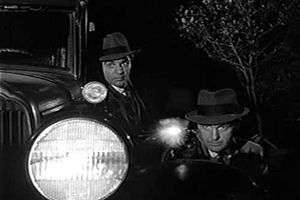
Al Capone Was Born Too Soon: Bank robberies involving large numbers of thieves with big guns, hostages, explosions, elaborate attempts to break into vaults -- these have become a recent staple of Hollywood, depicted in the films "Hancock," "The Dark Knight" and the new "The Town," to cite a just a few. Has any actual bank robbery ever resembled what the movies depict as typical? The 1997 North Hollywood shootout, in which 2,000 rounds were fired but no innocent person killed, is the closest.
"The Town" offers super-complicated bank robberies that last unrealistically long -- actual robbers want to get out as fast as possible -- and involve other unrealism. Let's hand it over to critic Gene Triplett, who says the movie offers "Lengthy, impossibly stunt-happy, fender-shearing car chases and machine-gun shoot-outs on public streets, with the four hijackers standing off what seems to be most of the Boston police force and an army of feds, escaping every time with nary a scratch. And what about that scene where the gang dons nuns' habits and scary Halloween masks, and marches into a robbery in broad daylight with automatic weapons in plain sight? This isn't going to cause passers-by to do a double-take?"
OK, it's just a ridiculous movie. The problem is "The Town" is masquerading as based on fact. Promotional materials claim that there are 300 bank robberies per year in Boston, that most of the robbers come from the little Charlestown district of the city, that automatic weapons fire is a common event in Boston bank robberies. Three hundred per year -- more than one bank robbery per work day in the same city? And how come nobody who lives in downtown Boston ever hears the supposedly daily automatic weapons fire?
Over to Maggie Lloyd of MIT's newspaper, who picks up the story using FBI data. Two hundred to 300 bank robberies occur per year throughout Massachusetts, not in Boston alone; there are no stats about Charlestown; gangs and weapons fire are extremely rare, with nearly all bank robbers being single individuals who pass notes to tellers and never show a weapon; attacks on bank vaults are extremely rare; all deaths linked to bank crime throughout the United States in 2009 were those of the perpetrators themselves.
Buck-Buck-Brawckkkkkkk (College Edition): Reader Mike Hutchins of Rhode Island notes that, when trailing Nebraska 49-21 late in the third quarter, Washington punted on fourth-and-3, at midfield. "I wrote Game Over in my notebook," he says. And yea, verily, it came to pass.
The Football Gods Chortled: "Vince Young is the highest-rated passer in the NFL," the CBS announcers said. Immediately, Young threw an interception to Troy Polamalu, setting in motion a seven-turnover meltdown by Tennessee. And a week after having the best game of his career, David Garrard threw four interceptions and was benched. The football gods chortled anew.
Speaking of passer ratings, I don't wish to alarm you, but so far, gruntled Jay Cutler is the league's top-rated passer. Joe Flacco is bottom-rated, at 41.2. If every pass an NFL quarterback attempts clangs to the ground incomplete, he receives a 39.6 rating. Flacco barely bests all-incompletion.

Crabtree Curse Update: TMQ has noted that the Forty-Niners' fortunes declined pretty much to the moment when Michael Crabtree suited up. Reader Jon Springer of Charlottesville, Va., supposes there is also a Spikes Curse. San Francisco starts linebacker Takeo Spikes, who is in his 14th NFL season and has never played for a winning team. "If the 49ers keep him, they cannot do better than an 8-8 finish," Springer predicts.
"Hey Dad, My Big Brother Was Mean to Me Again": Manning Bowl II was over by halftime. Considering the Colts have disdained the run for several consecutive games, Jersey/A came out in a dime, assuming pass. Peyton Manning, who basically calls his own plays, noticed the dime and called 23 rushes in the first half, for 124 yards. When the defense is in a dime, the offense has big guys blocking skinny guys, a favorable matchup for the rush. No Giants defender even touched Donald Brown on his first-quarter, 7-yard touchdown run, a simple stretch off-tackle.
Once Indianapolis had established the run, Manning began calling play-fakes. On first-and-10 at midfield in the second quarter, Manning play-faked; safety Michael Johnson bit hard on the fake, charging toward the line; Dallas Clark blew past cornerback Aaron Ross and caught a 50-yard touchdown pass with no safety deep. On this snap, a tight end outran a speed cornerback. Don't forget, the Colts are athletic as well as cerebral.
As for Jersey/A, trailing 31-7 near the end of the third quarter, New York Giants coach Tom Coughlin ordered a punt on fourth-and-5 from midfield. Players are lambasted when they quit on a game. Why aren't coaches?
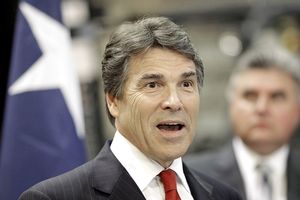
Wasteful Spending on Bodyguards Watch: TMQ rails against the trend for minor government officials, including mayors, state-agency directors and public university presidents, to have taxpayer-funded bodyguards -- not for any real security need but to make themselves seem more important. A reader from Indianapolis reports, "My wife works for a hotel in downtown Indianapolis. The governor of Texas, Rick Perry, attended the Indy 500 and stayed at her hotel. He brought eight Texas State Troopers with him, and had one on guard outside his hotel room at all times, as though he was the prime minister of a Middle Eastern nation. Indiana's governor, Mitch Daniels, rode his own motorcycle in the Indy 500 Festival Parade and had no bodyguards or police escort." Perry, the Texas governor, is renowned for railing against government waste. But, like so many politicians, Perry thinks "waste" is spending on other people, while for himself, he expects unlimited public largesse.
Two rare counterexamples: Alexander Chester of Bronx, N.Y., writes, "On our honeymoon, my wife and I found ourselves behind Mitt Romney in line at the Vatican. He was there with his wife and some grandchildren, no bodyguards. Romney is not in office, so if he wanted bodyguards, he would have to pay for them out of his own (admittedly deep) pockets. In any event Romney is far more recognizable than most of the others you have highlighted who are billing the taxpayer for security. If he doesn't need an army surrounding him, why do the rest of them?" And Brendan Wright reports that LeBron James was not granted a large police escort to attend the Ohio State-Miami (Florida) game. Why did he expect a police escort -- is he a head of state? Has he discovered a cure for cancer?
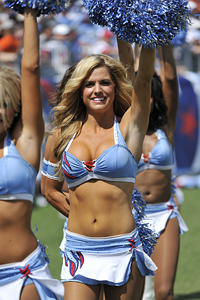
Suddenly It's 2003 Again for Michael Vick: Did the past few years of Michael Vick's life happen? You could not tell from his sharp performance Sunday -- though bear in mind, the lowly Lions lost by only three points, and had the ball at the end. Last week, TMQ called the zone-read option run, used by James Madison in its mega-upset of Virginia Tech, an "increasingly popular" tactic. For the touchdown that proved to be the winning points, a 46-yard run by LeSean McCoy, Eagles coaches radioed in a zone-read option.
Two More Concussion Points: Baseline testing -- football players take a mental reflex test in August -- is spreading, and that's a welcome development. A players' preseason mental baseline, stored on computer, allows trainers to make an initial evaluation of concussion severity, then track healing. Once baseline testing was expensive; now the price is falling. It should become universal.
Reader Corky Aiken writes, "My son plays for the eighth grade Westfield, Ind., middle school football team. This year, at the beginning of summer practice, each team member took a baseline cognitive assessment, which will be used as a guideline. If somebody sustains a head trauma, coaches and trainers will be able to have a clear picture of what he should be seeing, hearing and thinking when all is well. Until the mental functions of an athlete return to those baseline scores, he doesn't suit up, not even for practice. This assessment also is given to the volleyball teams and cheer squads, who have a propensity to get up-close and personal with hardwood floors. The trainer at the middle school is an associate with St. Vincent, part of the larger hospital complex where Peyton Manning helped build a kids' hospital. So the effort isn't just at Westfield, but in a good portion of the Indianapolis-area school districts."
Can concussions lead to suicide? Alan Schwarz of The New York Times, who has done a Pulitzer-quality job of pushing for public awareness on concussions, raised that grisly possibility last week, and ESPN's "Outside the Lines" added more Sunday. The story of a University of Pennsylvania football player who killed himself this past spring, and whose autopsy showed a brain condition called chronic traumatic encephalopathy, is heartbreaking.
But even as someone who thinks concussions are taken too lightly by the sports establishment, this story gave me pause. The Penn player had never been diagnosed with a concussion and had no history of neurological problems. The condition detected in his brain is poorly understood by medical researchers. About 35,000 males participate in college football annually. In the 15-24 age group, the annual suicide rate is about one in 10,000. Find a cohort of 35,000 people of that age, and, sadly, three or four suicides would be expected in any particular year. Maybe football contributed in some way to the Penn player's tragedy; often we'll never know why a person took his own life. Asserting that head trauma created a condition with no apparent symptoms that caused a suicide is pretty speculative.

Rex Ryan Finally Acts Like Rex Ryan: In the New York Jets' opening loss to Baltimore, Jersey/B played crazy on defense, hyperconservative on offense. Hosting New England on Sunday, the Jets once again seemed to be drawing up defenses in the sand, including using what TMQ calls the Times Square Defense -- everyone milling around pre-snap, like tourists walking and gawking in Times Square. Quarterbacks can't predict where defenders will end up at the snap because the defenders themselves don't know: They are instructed to move randomly. Bill Belichick has used the Times Square Defense more often than any other coach, but he didn't seem prepared for it.
On Sunday, the Jets finally took some chances on offense, going for the deuce after pulling ahead 19-14, then going for it on fourth-and-1 at midfield late to ice the contest. Ryan needs to get past his mindset that defense wins games while offense kills time until the defense comes back out. If Jersey/B can mount even an average offense, the Jets will be a team to deal with.
New England second-half possessions: interception, punt, interception, punt, fumble. Ye gods. The Flying Elvii turned the ball over three times, missed a short field goal and generally played like a bunch of guys who met each other for the first time in the parking lot just before kickoff.
Michael Crabtree on the Cover of Sports Illustrated Might Cause a Plague of Locusts: Three days before the Patriots' loss, Tom Brady made yet another appearance on the cover of Sports Illustrated.
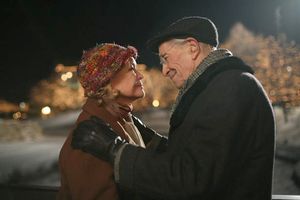
Christmas Creep: Palmer Blair of Providence, R.I., reports that his regional theater company begins its holiday run of "A Christmas Carol" before Thanksgiving. Frank Dicken of Edinburgh, Scotland, reports, "I've noticed several restaurants around town that are already taking reservations for Christmas dinners. One sign indicates that such dinners can be booked for as early as [Nov. 15]. Have your Christmas dinner six weeks before Christmas!" And Ivan Lovegren of Beverly Hills, Calif., notes that the first Christmas film of the year, the indie flick "Lovely Still," opened on Sept. 17 -- six days before the autumnal equinox and the end of summer.
Sweet Plays of the Week (College Bonus): Game scoreless, Southern Mississippi faced third-and-goal on the Kansas 1. The Golden Eagles lined up with double tight ends and two slotbacks right. Tailback V.J. Floyd took a handoff off-tackle right -- stopped, leaped into the air and tossed a pop pass to tight end Jonathan Massey, who had faked a block then ran into the end zone uncovered. The football world has seen the Tim Tebow play on which the quarterback fakes a sneak, then jumps to throw a pop pass to the tight end -- has a tailback ever done this? Southern Miss set the play up by running Floyd from the same formation on the previous snap and drew up the play well by putting both slotbacks in front of Floyd, so he wouldn't be crushed by defenders as he jumped into the air.

Trailing Notre Dame by three in overtime, Michigan State faced fourth-and-14 on the Irish 29. As the Spartans lined up for a field goal attempt, everyone assumed a kick to force a second overtime. Instead the holder and kicker ran to the right, simulating an option pitch to the kicker; the Notre Dame defense first was shocked, then went for the kicker; holder Aaron Bates threw deep to tight end Charlie Gantt for the touchdown that won the game.
The play design was sweet, but was this really a "bold gamble," as the sports world said? For a college kicker, a 46-yard attempt is a 50/50 proposition. Forcing another overtime is, itself, a 50/50 proposition. That means had Michigan State launched a field goal attempt, it would have carried a 1-in-4 chance of victory. The fake might have failed, but if it succeeded, victory was certain. So the decision by Michigan State coach Mike Dantonio was not a "bold gamble," it was playing the percentages. More coaches should play to win rather than to avoid losing! Dantonio -- today recovering from a mild heart attack -- also knew that it would never occur to the Notre Dame sideline that he would go for the win rather than take the "safe" course.
Obscure College Score of the Week: Malone 69, Anna Maria 0. A rare case in which an NAIA school beats up on an NCAA college. Malone ran up a 69-point margin despite Anna Maria not committing a turnover). Located in Canton, Ohio, Malone University, formerly Cleveland Bible College, is a strict Christian school. While other colleges deal with drunkenness and drug use, Malone sponsors a pumpkin hunt.
Bonus Obscure College Score of the Week: Citadel 26, Presbyterian 14. The Presbyterian Blue Hose -- referring to their socks, not to unhappy courtesans -- may be 0-3 and outscored 137-48. A Division I-AA school, they may have opened with consecutive hired-to-lose defeats at Wake Forest and Clemson. But they've run a trick-play touchdown to make Boise State envious. It's in the video box here. Located in Clinton, S.C., Presbyterian just opened a school of pharmacy and is charging students $40,300 a year to attend, though the school is not accredited -- which in college terms means any degree this school confers may prove worthless.
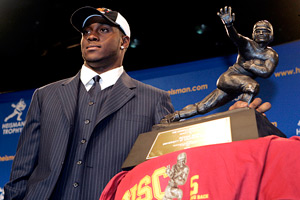
Two Cheers for Reggie Bush: Reggie Bush was smart to return the Heisman Trophy -- it ends the drip, drip, drip of the conspiracy. He should have apologized, too. But then he did nothing ethically wrong. He let an agent provide a house for family members during his USC years. That's a violation of NCAA rules, a reason he must return the trophy and USC must forfeit games. But Bush only broke a rule; he harmed no one and committed no crime. O.J. Simpson, a criminal -- currently in prison for armed robbery and earlier found liable by a civil jury for the wrongful death of Ronald Goldman -- remains in the Hall of Fame. Bush did the right thing, returning his award. When will the Hall of Fame do the right thing and expel the criminal Simpson?
Reader Comments: Last week, I deemed it "nutty" that officials at the East Carolina-Tulsa game assessed a celebration penalty for ECU's as-time-expired touchdown that gave the school a two-point victory -- how can it be wrong to celebrate after the game ends? I further complained that zebras would not allow East Carolina to waive the try, insisting on marching off 15 yards and making ECU snap the ball and kneel to conclude the contest. I'd always thought the try was an option for the offense, which could be waived if extra points are meaningless to the outcome.
Readers including Richard McDermott of Chicago countered, "In college football the defense can score two points on a returned deuce attempt. So didn't the refs have to make East Carolina line up for the PAT, on the extremely remote chance the Pirates did something other than a kneel-down and Tulsa returned a turnover?"
Kevin Lehde, a math teacher and high school football official in North Carolina, makes the call: "NCAA Rule 8-3-2a states that if the fourth quarter clock expires during a touchdown, 'the try shall not be attempted unless the point(s) would affect the outcome of the game.' Since the NCAA allows the defense to score two points if they return a fumble or interception during a try, the officials acted correctly." In the NFL, an extra point attempt cannot be returned, so officials would be unlikely to compel a scoring team to line up for a try and then kneel. NFL rules say a scoring team is "offered" a try, but may decline. Coaches usually want the extra point, even if time has expired, against the long-shot prospect that a net-points tiebreaker determines a playoff slot. Under the NFHS rules used in most high school games, unless playoff positioning is affected by point differentials, the try is automatically waived if it would have no outcome on the game. The defense can't return PATs under NFHS rules, so in most cases the situation from ECU-Tulsa contest does not arise in high school.

I complained that book-like-objects, such as "Game Change" and Tony Blair's "A Journey," cheapen the written word by placing into quotation marks material that is imagined. Alex Hryhorczuk of Urbana, Ill., writes, "Glamorizing non-fiction with made-up quotations is nothing new. Thucydides used speeches in his History of the Peloponnesian War that he could not have had access to, such as the military strategy sessions of enemy officers. To his credit, he warns readers that such speeches are literary representations only. Modern authors don't seem to feel any such need to be so responsible."
Thanks to Kevin Lehde for looking up the rule, and McDermott offers the below haiku on waiting for Tuesday Morning Quarterback to post. (Readers can sign up for a Twitter announcement of when TMQ posts -- that's all you will get, I do not clog your text-mail inbox.)
Anxiously I click.
Yes, it is there. Tee Em Cue.
Sanity now reigns.
-- Richard McDermott, Chicago
Eric Loberg of Bozeman, Mont. writes, "Division I-AA teams can have cupcakes, too. The Division I-AA Montana Grizzlies hired Division II Western State to roll over 73-2 on Sept. 4, moving the Grizzlies to the No. 1 spot in the FCS polls. The football gods, angered at such a display, promptly imposed back-to-back division losses of the Grizzlies, at Cal Poly and at Eastern Washington. Apparently the football gods are not pleased with blowout wins over cupcakes to earn voter support in the polls."
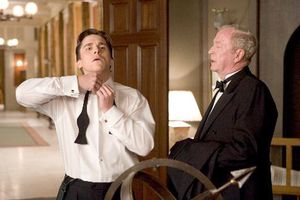
Hollywood endlessly gives us action heroes who effortlessly beat up a dozen strong men -- at least a dozen strong stuntmen, who cooperate in being beaten up. I've been recounting the latest trend -- aging stars such as Sly Stallone, Morgan Freeman and Helen Mirren who engage in a sort of cinematic self-flattery by playing characters who can effortlessly win kickboxing fights despite their ages. John Gaugler of Seattle adds to the list 77-year-old Michael Caine, who played an anti-gang-vigilante in the 2009 British movie "Harry Brown": "In the flick, Caine takes on a group of young gang members -- but is also hospitalized at one point for emphysema."
Finally, last week readers weighed in on the absurdity of police escorts that stop traffic for football team buses or even for football announcers. John Monahan writes, "Check this from Penn State's athletics website, about arrival for the Alabama game: 'Three buses were waiting for the squad on the tarmac in Birmingham. The team departed for the Marriott Birmingham with a tremendous police escort from the Alabama State Police. Five motorcycles and three cars led the buses off the tarmac. Alabama's finest paved the way to the hotel in the middle of rush-hour traffic. The motorcycles blocked entranceways on the freeway, cleared intersections and stopped traffic throughout the 20-minute drive to the hotel. It felt like we were the only vehicles on the road during the busiest time of day in the city of Birmingham. A tip of the cap goes to the Alabama State Police.' Tip of the cap? This account is disgusting. Busiest time of the day in a heavily populated city and the visiting team gets a free ride at the taxpayers' expense."
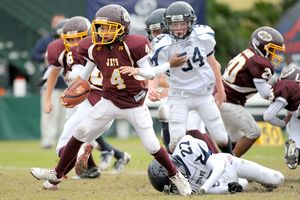
Lisa Vargas Gardner of Pasadena, Calif., writes, "My husband and I live less than a half mile from the Rose Bowl and walked down for the recent UCLA-Stanford game. As we tried to cross the street in front of our house to start the walk to the bowl for a tailgate, a Pasadena motorcycle cop pulled up, lights flashing, sirens blaring and frantically waved us back onto the sidewalk. We assumed one of the teams' buses would be shortly behind -- that's bad enough. Instead we saw cars with their hazard lights flashing. Some of the cars had PeeWee football logos. Turns out, the game's halftime entertainment was a scrimmage between two PeeWee teams. The PeeWee players were getting a stopped-traffic police escort."
Next Week: Pop Warner teams demand flyovers for ankle-biter games.
In addition to writing Tuesday Morning Quarterback for Page 2, Gregg Easterbrook is the author of the new book "Sonic Boom" and six other books. He is also a contributing editor for The New Republic, The Atlantic Monthly and The Washington Monthly. His website can be found here.
 |
| • Philbrick: Page 2's Greatest Hits, 2000-2012 |
| • Caple: Fond memories of a road warrior |
| • Snibbe: An illustrated history of Page 2 |
| Philbrick, Gallo: Farewell podcast |
- Author of "The King of Sports"
- Former Fulbright distinguished fellow
- Contributing editor to "The Atlantic"
ALSO SEE
ESPN TOP HEADLINES
RECENT ACTIVITY
-
TOOLS
- Contact Us
- Corrections
- Daily Line
- RSS
